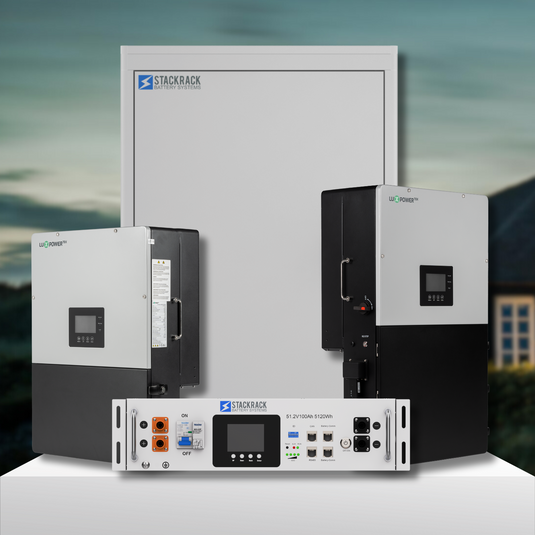StackRack Residential Blog
-

A Beginner’s Guide to Choosing the Best Hybrid Inverter for Your Home
Hybrid inverters represent a significant advancement in home energy management, offering efficiency, reliability, and cost savings. They are particularly valuable for homeowners looking to integrate solar power and ensure a continuous energy supply. By understanding the differences and benefits of hybrid inverters, you can make an informed decision that best suits your energy needs.
For homeowners and solar installers looking to explore these advanced solutions, now is a great time to consider upgrading to a hybrid inverter. With leading brands like Sol-Ark and Luxpower offering robust and affordable options, there's a perfect fit for every home.
-

Power Up Your Home with the Right Sized Battery System
StackRack's innovative modular battery systems are revolutionizing home energy solutions by offering adaptable and scalable options for peak shaving, partial off-grid living, and full energy independence. Discover the importance of choosing the right battery size tailored to your unique energy usage and goals. With StackRack's compatibility with leading inverters and ease of expansion, powering your home reliably has never been easier. Explore our comprehensive guide to understanding battery requirements and take the next step towards a sustainable energy future. Visit StackRack to learn how our solutions fit your needs. -

NEM-3 Explained: What Every California Homeowner Needs to Know
As more Californians turn to solar energy, understanding the latest policy changes is crucial. The new Net Energy Metering 3.0 (NEM-3) policy, which took effect on April 15, 2023, brings significant changes to how solar system owners are compensated for excess electricity. Under NEM-3, credits for exported energy are now calculated using the Avoided Cost Calculator (ACC), resulting in lower rates compared to previous versions. These rates are locked in for the first nine years after installation.
To ease the transition, NEM-3 introduces "adders" that boost the financial benefits of solar installations, particularly for low-income customers and those in disadvantaged areas. These adders are highest for early adopters, providing an incentive to install solar sooner.
For existing NEM-1 or NEM-2 customers, adding a battery won't affect their current status, but expanding their solar capacity might shift them to NEM-3 rules unless certain conditions are met. Understanding these changes is key for anyone considering solar energy in California.
For new NEM-3 solar customers, adding battery storage can help you get the best return on investment (ROI). With batteries, you can generate, store and use your energy. This helps you reduce the grid energy, which helps you save on your electric bill. For any battery-related questions, we're here to help. Give us a call or send us an email to help design your solar and battery system today. Also, you can visit our website for complete battery system kits for your home.
-

Three Ways Batteries Can Help you Save in NEM-3.0
In the evolving landscape of NEM-3.0, battery storage has become a pivotal component for homeowners seeking to optimize their energy savings. This policy shift reduces export rates, urging homeowners to efficiently store and utilize their solar energy. Key strategies under NEM-3.0 include focusing on self-consumption and achieving grid independence. With export rates being determined by the Avoided Cost Calculator (ACC), storing energy for evening use offers financial benefits, as evening rates can be significantly higher.
The article explores effective battery strategies, emphasizing the balance between solar array size and battery capacity to maximize return on investment. Smaller batteries can help dodge peak energy costs, while larger systems are ideal for selling energy back at optimal rates and power your home with as little grid energy a. Additionally, the trend towards off-grid living is gaining traction, with advancements in solar and battery technology making it more feasible. Homes can now rely on a mix of solar panels, battery systems, and standby generators to reduce utility dependence.




